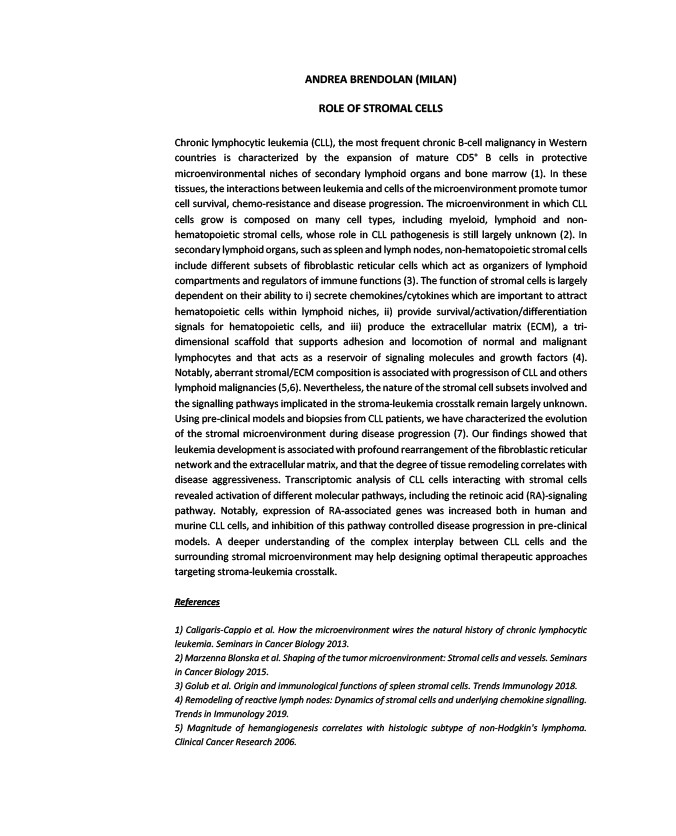
ANDREA BRENDOLAN (MILAN)
ROLE OF STROMAL CELLS
Chronic lymphocytic leukemia (CLL), the most frequent chronic B-cell malignancy in Western
countries is characterized by the expansion of mature CD5+ B cells in protective
microenvironmental niches of secondary lymphoid organs and bone marrow (1). In these
tissues, the interactions between leukemia and cells of the microenvironment promote tumor
cell survival, chemo-resistance and disease progression. The microenvironment in which CLL
cells grow is composed on many cell types, including myeloid, lymphoid and non-hematopoietic
stromal cells, whose role in CLL pathogenesis is still largely unknown (2). In
secondary lymphoid organs, such as spleen and lymph nodes, non-hematopoietic stromal cells
include different subsets of fibroblastic reticular cells which act as organizers of lymphoid
compartments and regulators of immune functions (3). The function of stromal cells is largely
dependent on their ability to i) secrete chemokines/cytokines which are important to attract
hematopoietic cells within lymphoid niches, ii) provide survival/activation/differentiation
signals for hematopoietic cells, and iii) produce the extracellular matrix (ECM), a tri-dimensional
scaffold that supports adhesion and locomotion of normal and malignant
lymphocytes and that acts as a reservoir of signaling molecules and growth factors (4).
Notably, aberrant stromal/ECM composition is associated with progressison of CLL and others
lymphoid malignancies (5,6). Nevertheless, the nature of the stromal cell subsets involved and
the signalling pathways implicated in the stroma-leukemia crosstalk remain largely unknown.
Using pre-clinical models and biopsies from CLL patients, we have characterized the evolution
of the stromal microenvironment during disease progression (7). Our findings showed that
leukemia development is associated with profound rearrangement of the fibroblastic reticular
network and the extracellular matrix, and that the degree of tissue remodeling correlates with
disease aggressiveness. Transcriptomic analysis of CLL cells interacting with stromal cells
revealed activation of different molecular pathways, including the retinoic acid (RA)-signaling
pathway. Notably, expression of RA-associated genes was increased both in human and
murine CLL cells, and inhibition of this pathway controlled disease progression in pre-clinical
models. A deeper understanding of the complex interplay between CLL cells and the
surrounding stromal microenvironment may help designing optimal therapeutic approaches
targeting stroma-leukemia crosstalk.
References
1) Caligaris-Cappio et al. How the microenvironment wires the natural history of chronic lymphocytic
leukemia. Seminars in Cancer Biology 2013.
2) Marzenna Blonska et al. Shaping of the tumor microenvironment: Stromal cells and vessels. Seminars
in Cancer Biology 2015.
3) Golub et al. Origin and immunological functions of spleen stromal cells. Trends Immunology 2018.
4) Remodeling of reactive lymph nodes: Dynamics of stromal cells and underlying chemokine signalling.
Trends in Immunology 2019.
5) Magnitude of hemangiogenesis correlates with histologic subtype of non-Hodgkin's lymphoma.
Clinical Cancer Research 2006.